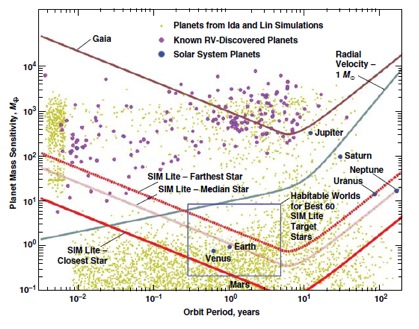|
Supporting Exoplanet Papers
SIM Lite ExoEarth Discovery Zone
SIM Lite will search for Earth-mass planets in the habitable zones around the nearest 60 solar-type stars — a capability unmatched by any existing instrument or instruments currently in development.
This graphic illustrates the sensitivity of different methods for discovering and analyzing exoplanets plotted with mass sensitivity of the technique vs. exoplanet orbital period. Maximum sensitivity limits are presented for Gaia (brown curve) and radial velocity (RV) searches to 1M? are plotted (grey curve). For SIM Lite, the sensitivity for finding a habitable exo-Earth is presented (red and pink curves) for both the easiest and most difficult stars and a median star among its best 60 target stars.
Plotted in the background are planets from Ida and Lin simulations, many of the known planets discovered by RV measurements, and solar system planets from Venus through Neptune. SIM Lite can discover habitable worlds in a large volume of Mass-Period space for F-G-K stars.
 Chart detailing SIM Lite's planet-finding capabilities.
The SIM-Radial Velocity Double-Blind Simulation to Detect Earths in Multi-Planet Systems
""
""
""
""
""
"
"
|
 |